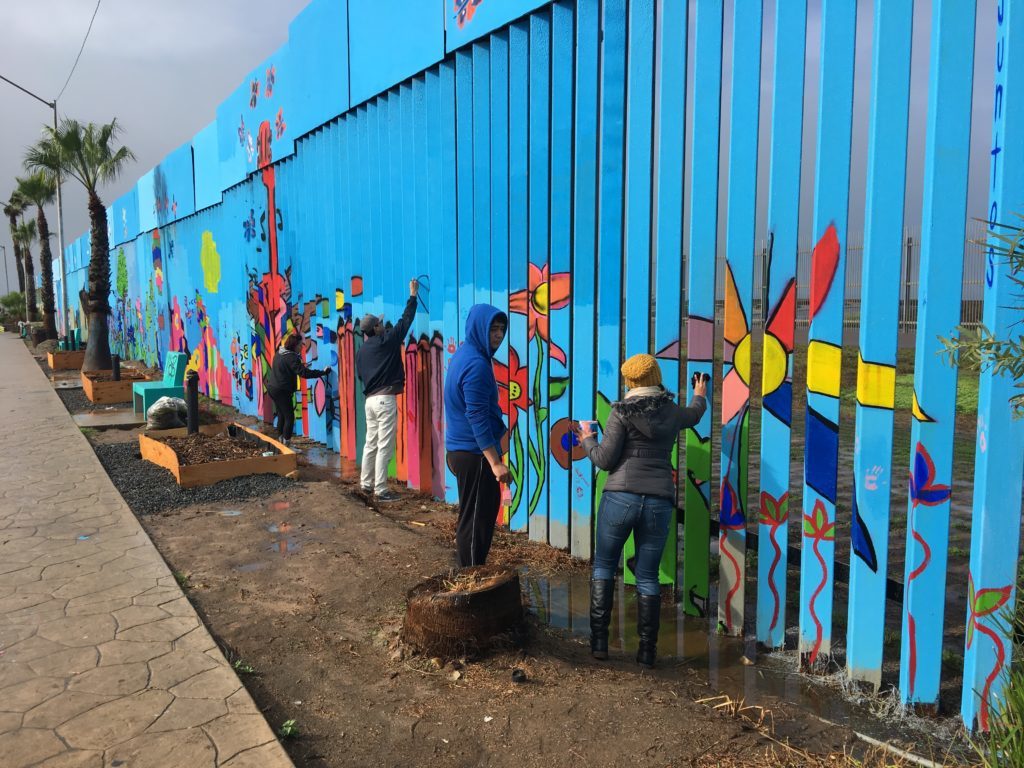Rev. Dan Schatz
Unitarian Congregation of West Chester
February 3, 2019
Come.
Cross the border.
Come to this place
of welcoming hands and open minds,
of hearts given to justice,
and souls outstretched
in search of truth.
Come,
and be welcome.
“Where Is My Stolen Child Tonight,”
sung by Rev. Dan Schatz and congregation
Naco, Arizona is half of a town. The other half is also Naco, in the Mexican state of Sonora, and between the two, for years, there was a low chain link fence fortified with rusting steel beams. Every day, traffic would run through the border, back and forth through the small checkpoint. Families not permitted across might come to the fence to see their relatives, and exchange a meal or a besito (a little kiss) over the barrier.
The culture of the area is a true mixture – Mexican, Anglo, and Native cultures come together here, so you might hear fiddle and accordion polkas with Spanish lyrics played by the Native Tohono O’odham community that straddles the border. They call it “chicken scratch music,” and like so much of the culture in the Southwest United States and Northern Mexico, it owes as much to German and Spanish traditions as to native ones.
Once a year, in April, families gather on both sides of the fence. Half live in Mexico, half in the United States, and all of them live in Naco. They bring food, set up tents, play music, and organize games for children. Together they set up a big shade canopy with two feet on each side of the fence, all, as the Mayor of Mexican Naco said, to “celebrate the union of two countries.” It’s called the Fiesta Bi-Nacionál, or bi-national festival, and they’ve even attracted corporate sponsors to this little border town.
But picnics and music can only go so far. The big highlight of the Fiesta Bi-Nacionál is the volleyball game. It’s Mexican Naco versus US Naco – and the net is the border fence. They’ve played every year since 1979.
I don’t know what they’re going to do this coming Spring. In 2017, the border patrol began putting up a wall made of 20 foot steel slats. Traffic back and forth across the border has slowed, fewer and fewer Mexicans are allowed into the United States, and the businesses that lined the border have been shuttered. Instead of besitosover a fence, families now push themselves against the steel to catch a glimpse and a conversation. It’s the same up the road in in the larger town of Nogales, and elsewhere along the border. Boarded up stores, broken families.
Walls don’t have to be the end of it. In Tijuana the Mexican locals refuse to accept the wall as an insult or a stark monument to division. Instead, they’re painting the world’s longest mural – decorated in themes of peace and unity between nations. They’ve already done one and a half miles, but have plans to go for hundreds, if the wall gets built, and if they can get permission they want to paint on the American side as well. They call it “The mural of brotherhood.” The artist who started the project, Enrique Chiu, said, “Through art and the will of people, a social and cultural movement is being made that can fill people with positive feelings and send messages in this huge canvas we have. Every weekend people, friends, and artists keep arriving to achieve this union.” Asked what he would do if the United States built a wall across the entire border, he said, “If Trump gives me a canvas, I will paint it.”

“Something there is that doesn’t love a wall…,” said Robert Frost, “There where it is we do not need the wall….” His neighbor tells him, “Good fences make good neighbors,” and Frost asks,
“Why do they make good neighbors?…
Before I built a wall I’d ask to know
What I was walling in or walling out,
And to whom I was like to give offence.
Something there is that doesn’t love a wall,
That wants it down.”
A wall is a monument to division. There are times when they are necessary; I know that. Other times walls are useless, like the wall between two orchards Robert Frost describes, or harmful, like the wall that has torn apart the town of Naco.
“Something there is that doesn’t love a wall.”
Despite my obvious objections, I do understand why the idea of a border wall has so much appeal to some people. “Why not?” a person might ask, “I mean, we have a border, right? A border sets things apart. It says, ‘this is one place and this is another.’ All a wall does finish the job.”
But a border is more than a line drawn in sand. A border is a place of coming together. People who live in border communities know this. Families live on both sides of the border. People do business together; they work on projects together, they solve problems together. On the Tohono O’odham land there is an international market where people from both countries come to buy and sell their produce.
The same is true of borders everywhere. In Minnesota and Manitoba, there is a place where a local school bus crosses the international border four times, each way, every day, to and from school. Border communities are not meant to be apart from each other. They live together, as people do.
You can see, hear it, and taste it. It’s in the art, the architecture, even the cemeteries are largely the same on either side of the border. It’s in the food – the “Mexican food” most of us enjoy comes largely from the borderlands, a combination of Mexican and Anglo cuisines. In central Mexico, most people wouldn’t even recognize it. The chicken scratch music in the Tohono O’odham lands in Sonora and Arizona is not that different from the conjunto music of Texas – the polkas, the accordion, the coming together of cultures. After all, “joined together” is literally what conjunto means.
James Griffith is a folklorist who describes borderlands not as separated, but as “a shared space.” A border community, he says, is “a place of cultural negotiation…. For the traveler from Michigan, USA, or from Michoacan, Mexico, the foreign flavor starts long before one arrives at the boundary line between the two nations, and reminders of home persist long after one has crossed over into the other country.” I find that beautiful. I recognize that for those who place their faith in nationalism and White supremacy, it is terrifying.
A border is a place of coming together. Walls drive people apart.
A border is a mixing of culture, art, families, and ethnicities. Walls divide “us” into two sets of “them.”
A border is a space between that is neither one nor the other, but both. Walls separate.
A border is place of creativity. Walls are a cutting off of possibility.
I think that as Unitarian Universalists we know as well as anyone what it is like to live in borderlands, although we don’t tend to think of it in those terms. We are, by definition, a mixture – a coming together of traditions, a constant negotiation among theologies, ideas, and spiritual practices. We depend on that kind of diversity to be the religion that we are. We live our religious lives in a border space. We love it. And we don’t build walls.
Instead we embrace differences, listen to each other, and learn from each other. We share practices informed by a diversity of cultures and theologies. Ours is a borderland religion. (Note that I did not say it is borderline religion. That would mean something else entirely.)
As a Unitarian Universalist I know in a personal and almost visceral way the good that arises from the mixing and trading and learning and listening and sharing that defines a border far more accurately than a line could ever do. And I am coming to the conclusion that borders at their very best are holy places.
Henry Nelson Wieman, one of the great Unitarian Universalist theologians, defined God as “creative interchange.” God is creative interchange. That’s what takes place at the borders – a sacred coming together. That volleyball game in Naco, and the ones that have begun more recently in Tijuana, and elsewhere up and down the border, are sacred events, because they give life to the unity of two peoples. The melodies and art, the culture of the southwest and of northern Mexico are holy, because they represent the creative good.
I am not the only Unitarian Universalist to recognize this. In Amado, Arizona, just up the road from Nogales, and only a couple hours drive from Naco, the Unitarian Universalist Congregation of Green Valley, this week changed its name to Borderlands Unitarian Universalist. The change, they said, reflects a deeper and better understanding of who they are called to be.
Something there is that doesn’t love a wall.
There are all kinds of walls in this world. Some are built of concrete, some of steel slats, and some are built of words or even feelings. Racism, sexism, homophobia, transphobia, religious hatred – all of the ideologies and systems that tear people apart from each other – are walls of the spirit. Stubbornness, self-righteousness, fear of change, fear of difference, self-centeredness – these also are walls, and there probably isn’t a person among us who hasn’t put up a few of them at some time in our lives.
Almost invariably, when we are able to let go of those kinds of walls and allow ourselves to live in the borderlands, our lives are better because of it. We are healthier, we are more creative, our relationships are more fulfilling, and we experience love more deeply, because we looked beyond walls to the borders themselves, and we found that we were home.
This, I believe, is what our nation, and perhaps all nations, needs to learn to do. Because the truth is that as humanity becomes more closely connected – through technology, communications, common need – the borders will not get any smaller. Remember the guy in 2016 who threatened that if we didn’t slow immigration there’d be “a taco truck on every corner?” And a lot of us said, “Great! How soon?” He wasn’t completely wrong. The borderlands are growing, and they will grow to include all of us, and no wall can stop that. No fence can prevent it.
Build a fence, and somebody will use it to play volleyball. Build a wall, and someone will turn it into art. Build hatred, and someone – we– will answer with love.
Love beyond walls, unity beyond division, community always – these are the values of the world we are creating together. And together, we are creating a sacred world.
Sacred spirit of unity,
Espiritu sagrada de la unidad
Ayúdanos.
Help us.
In an era of division,
we labor for greater community.
Through fear,
we hold on to the hope that is born
when people come together
in common purpose.
Oppressed by hatred,
we give ourselves
to the transforming power of love.
Spirit of unity,
Espiritu de la unidad,
Ayúdanos.
Help us.
Help us
to move beyond walls.
Ayúdanos.
Help us
to live in the borderlands.
Ayúdanos.
Help us
to awaken eyes and ears and touch
and every sense,
cada sentido,
to the vision we carry,
of an earth made one
in all its beauty.
Amen,
Bendiga,
and blessed be.

